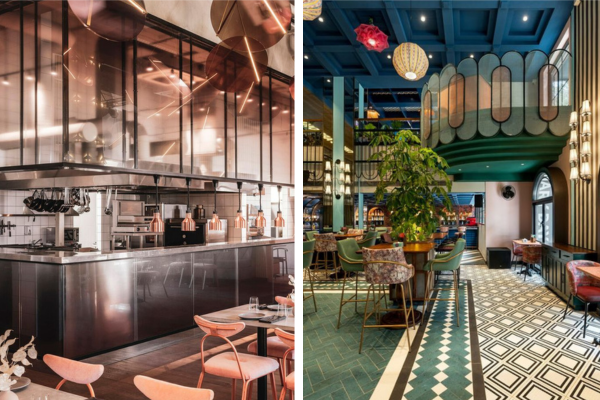“Design is not just what it looks like and feels like. Design is how it works.”
-Steve Jobs
In the dynamic realm of culinary arts, the ambience of a restaurant plays a vital role alongside the Flavors it offers. As we enter 2023, a year marked by innovation and artistic exploration, the field of restaurant interior design is undergoing a captivating metamorphosis. From eco-conscious spaces to immersive dining encounters, let’s delve into the prominent restaurant design trends reshaping the gastronomic landscape.
These trends are revolutionising the way we experience dining, and they include everything from sustainable practices to creating unforgettable atmospheres. For instance, ‘Chic Cafe Interior Design‘ is a prime example of how aesthetics and ambience play a pivotal role in crafting unique dining experiences. Join us on this journey as we explore these exciting design innovations setting the stage for the future of dining.

1. Sustainability Takes Center Stage: A Green Revolution
In a world increasingly focused on sustainability, restaurant design embraces the ethos of environmental consciousness. Eco-consciousness is at the forefront of the movement, with restaurants embracing sustainable practices and materials to create harmonious spaces that blend seamlessly with nature.
Living walls, cascading water features, and recycled materials are commonly featured elements that evoke a sense of serenity and connection to the earth. The year 2023 witnesses the ascent of biophilic design, wherein nature seamlessly integrates into interiors.
Living walls adorned with lush greenery, repurposed wood accents, and energy-efficient lighting not only create visually appealing environments but also resonate with environmentally conscious diners.
For instance, in rooftop restaurant interior design, these elements can be thoughtfully incorporated to not only enhance aesthetics but also to provide a sustainable and eco-friendly dining experience.
2. Digital Integration : The Fusion of Design & Technology
The march of technology has ushered in a new era of restaurant design characterised by innovative concepts that enhance the dining experience. Touchless menus and digital ordering systems are becoming ubiquitous, minimizing physical contact while ensuring a seamless dining experience.
Augmented reality (AR) elements, too, are making their way into restaurant interiors, offering diners immersive narratives about the restaurant’s heritage, the sourcing of ingredients, or even the dishes themselves, enriching the overall culinary journey.
Here are a few specific examples of technology-driven restaurant design trends:
- Touchless Menus and Digital Ordering Systems: Touchless and digital ordering systems allow diners to browse the menu and place orders without contacting physical menus or wait staff. This can help to reduce the spread of germs and create a more hygienic dining environment.
- AR Elements: AR elements can be used in various ways to enhance the dining experience. For example, AR menus can provide diners with additional information about the dishes, such as nutritional information, ingredient sourcing, or even behind-the-scenes footage of the prepared dish. AR can also create interactive experiences, such as virtual wine tastings or cooking demonstrations.
- Innovative Kitchens: Smart kitchens use technology to optimize efficiency and reduce waste. For example, smart refrigerators can track inventory and suggest recipes based on what’s on hand. Smart ovens can cook food to perfection with minimal human intervention. And smart dishwashers can clean dishes more efficiently and use less water.
- Robotic Servers: Robotic servers are becoming increasingly common in restaurants, delivering food and drinks to tables and clearing dishes. This can help to reduce labour costs and improve efficiency.

3. Culture as a Design Muse
Restaurants are now embracing global cultural influences not only in their menus but also in their design aesthetics. Diverse cultural inspirations influence color palettes, patterns, and architectural elements. From Mediterranean tiles to intricate Asian murals, these design components transport diners across continents, elevating their dining escapades.
For instance, Boho Chic Restaurant Interiors have gained popularity as a prime example. With their eclectic and free-spirited design, they infuse a sense of wanderlust and creativity into the dining experience, making patrons feel like globetrotters exploring diverse cultures with every visit.
Here are some examples of cultural design trends and their features:
- Moroccan design is a popular choice for restaurants, with its vibrant colors, intricate patterns, and mosaic tiles. Moroccan-inspired restaurants often feature arched doorways, lanterns, and plush seating, creating a warm and inviting atmosphere.
- Japanese design is another popular choice for restaurants, with its emphasis on natural materials and minimalist aesthetic. Japanese-inspired restaurants often feature wooden elements, bamboo accents, and Zen gardens, creating a serene and calming ambiance.
- Indian design is known for its bold colors, intricate carvings, and luxurious fabrics. Indian-inspired restaurants often feature ornate chandeliers, colorful tapestries, and carved wooden furniture, creating a feast for the senses.
- African design is becoming increasingly popular for restaurants, with its mudcloth, tribal masks, and vibrant colors. African-inspired restaurants often feature thatched roofs, carved wooden furniture, and traditional African art, creating a unique and immersive dining experience.
4. Modernity Meets Nostalgia : Contemporary Reimagined
A delightful restaurant design trends in 2023 is the fusion of contemporary design with nostalgic elements. Restaurants are skillfully blending modern aesthetics with retro-inspired décor, such as mid-century furniture alongside avant-garde lighting. This fusion evokes comfort and familiarity while exuding an air of novelty, making it appealing to a diverse array of patrons.
This trend is prevalent among millennials and Gen Z, who are drawn to the unique and eclectic aesthetic. They appreciate the nostalgia of retro-inspired elements while also being drawn to the modernity of contemporary design.
Here are a few specific examples of how restaurants are fusing contemporary and nostalgic elements in their design:
- Mid-century furniture: Mid-century furniture is a popular restaurant choice, with its clean lines and timeless elegance. Mid-century furniture can be paired with contemporary elements, such as exposed brick walls and metal accents, to create a unique and stylish space.
- Retro-inspired décor: Other popular retro-inspired décor elements include vintage signage, neon lights, and retro vinyl players. These elements can be used to add a touch of nostalgia to a contemporary space.
- Contemporary lighting: Contemporary lighting fixtures, such as Edison bulbs and geometric pendants, can add a touch of modernity to a retro-inspired space.
- Neutral colour palette: A neutral palette is often used to create a cohesive and balanced space when fusing contemporary and nostalgic elements. Neutral colours, such as white, beige, and grey, can be paired with pops of colour from accent walls or furniture.
Fusing contemporary design with nostalgia is a creative and innovative trends transforming the restaurant design landscape. By creating spaces that are both modern and familiar, restaurants can appeal to a broad range of patrons and create a truly unique and memorable dining experience.

5. The Texture Renaissance : A Feast for the Senses
The texture is taking centre stage in 2023 restaurant design, with designers experimenting with tactile elements to craft multisensory dining experiences. From sumptuous upholstery to intricate ceramics, diners are encouraged to engage with their surroundings tactilely. This trends adds layers to the design narrative, fostering a deeper emotional connection between patrons and the space.
Here are a few specific examples of how restaurants are incorporating texture into their design in 2023:
- Upholstery: Velvet, boucle, and leather upholstery are all popular choices for restaurants, adding a touch of luxury and softness to the space.
- Wall coverings: Textured wall coverings, such as grasscloth, linen, and wood panelling, can add visual interest and depth to a space.
- Flooring: Textured flooring materials, such as terracotta tiles, concrete, and reclaimed wood, can create a warm and inviting atmosphere.
- Lighting: Textured lighting fixtures, such as woven baskets and rattan lamps, can add whimsy and personality to a space.
- Décor: Textured décor elements, such as ceramic vases, macrame planters, and artisanal baskets, can add visual interest and depth to a space.
6. Scheduled Havens : Intimacy Redefined
The concept of private dining is evolving creatively, giving rise to individual dining pods and cosy cocoon-like seating arrangements. These intimate enclaves offer seclusion while retaining a connection with the larger dining area. Whether in suspended bubble pods or enclosed booths, this trends caters to individuals seeking a personalised dining encounter within shared spaces.
This trend is being driven by several factors, including:
- The desire for privacy: In today’s fast-paced and connected world, people increasingly crave privacy and moments of respite. Individual dining pods and cosy cocoon-like seating arrangements provide a haven where diners can relax and enjoy their meal without distractions.
- The rise of personalised dining: Diners are increasingly looking for dining experiences tailored to their individual needs and preferences. Individual dining pods and cosy cocoon-like seating arrangements allow diners to control their environment, from the lighting and music to the temperature and privacy. For instance, an Art Deco restaurant interior might incorporate this trends by offering private dining spaces with plush, vintage-inspired furnishings, iconic Art Deco patterns, and customised lighting options.
- The increasing popularity of shared spaces: Shared spaces, including co-working areas and food halls, are gaining popularity in contemporary design. They foster community and vibrancy, allowing people to come together. However, it’s not just limited to co-working or food halls; it extends to modern coffee shop design as well.In modern coffee shops, you’ll often find individual dining pods and cosy cocoon-like seating arrangements. These design elements provide patrons with the advantages of shared spaces, such as a sense of community and energy, while ensuring privacy and seclusion.

7. The Cullinary Art Gallery : Reinventing Open Kitchens
Open kitchens have long been a staple in restaurant design, but 2023 witnessed a transformation into theatrical culinary showcases. Chefs assume the role of performers on a culinary stage, and restaurant layouts are strategically designed to spotlight their gastronomic craftsmanship. Transparent kitchen spaces, interactive cooking stations, and even chef’s tables nestled within the kitchen heighten the dining experience by bringing culinary artistry to the forefront.
The restaurant design trends of 2023 epitomise the industry’s adaptability and innovative spirit. From sustainable practices to immersive technologies, the dining landscape is evolving to cater to the evolving preferences of consumers. As interior designers of Oraanj Interior Design continue to push the boundaries, we can anticipate more imaginative and visionary concepts that redefine the very essence of the lover. So, whether you’re a dedicated food enthusiast or a design lover, these trends invite you to relish not only culinary delights but the entire sensory symphony of dining ambience.
Author: Aisha Singh and Oluwatomi Olaosebikan (Interior Designer)

